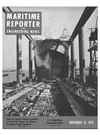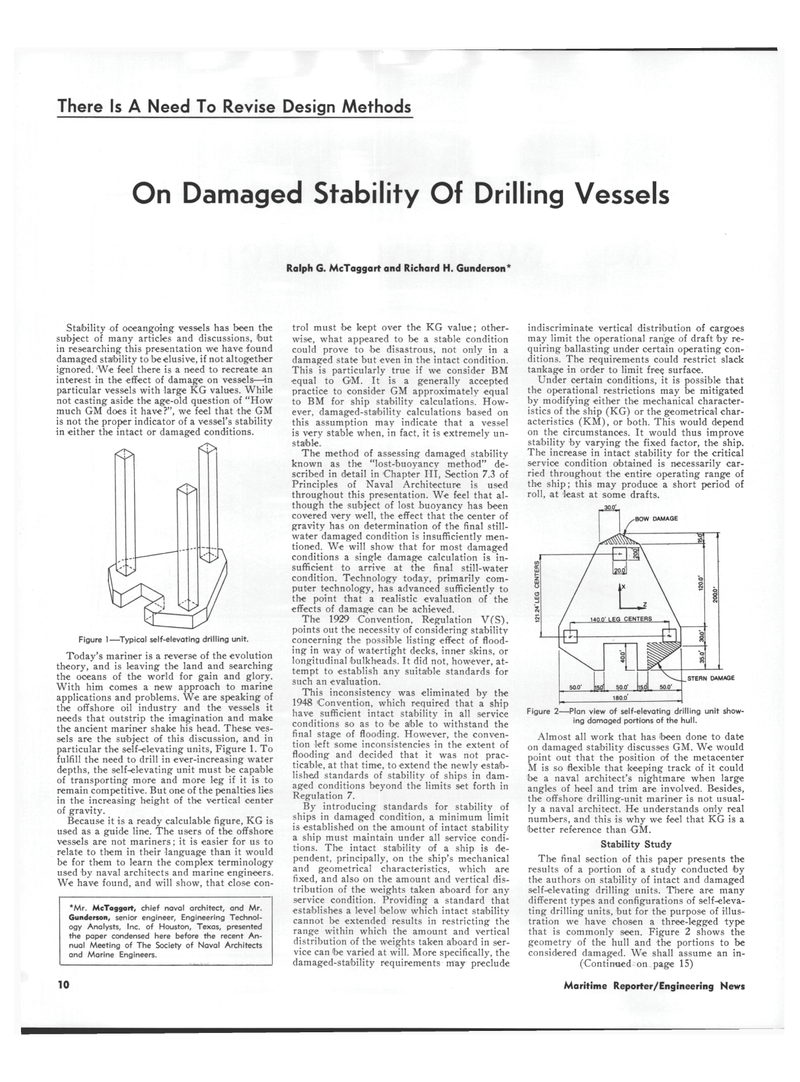
Page 8: of Maritime Reporter Magazine (November 15, 1973)
Read this page in Pdf, Flash or Html5 edition of November 15, 1973 Maritime Reporter Magazine
There Is A Need To Revise Design Methods
On Damaged Stability Of Drilling Vessels
Stability of oceangoing vessels has been the subject of many articles and discussions, but in researching this presentation we have found damaged stability to be elusive, if not altogether ignored. 'We feel there is a need to recreate an interest in the effect of damage on vessels—in particular vessels with large KG values. While not casting aside the age-old question of "How much GM does it have?", we feel that the GM is not the proper indicator of a vessel's stability
Today's mariner is a reverse of the evolution theory, and is leaving the land and searching the oceans of the world for gain and glory.
With him comes a new approach to marine applications and problems. We are speaking of the offshore oil industry and the vessels it needs that outstrip the imagination and make the ancient mariner shake his head. These ves- sels are the subject of this discussion, and in particular the self-elevating units, Figure 1. To fulfill the need to drill in ever-increasing water depths, the self-elevating unit must be capable of transporting more and more leg if it is to remain competitive. But one of the penalties lies in the increasing height of the vertical center of gravity.
Because it is a ready calculable figure, KG is used as a guide line. The users of the offshore vessels are not mariners; it is easier for us to relate to them in their language than it would be for them to learn the complex terminology used by naval architects and marine engineers.
We have found, and will show, that close con- *Mr. McTaggart, chief naval architect, and Mr.
Gunderson, senior engineer, Engineering Technol- ogy Analysts, Inc. of Houston, Texas, presented the paper condensed here before the recent An- nual Meeting of The Society of Naval Architects and Marine Engineers.
Ralph G. McTaggart and Richard H. Gunderson* trol must be kept over the KG value; other- wise, what appeared to be a stable condition could prove to be disastrous, not only in a damaged state but even in the intact condition.
This is particularly true if we consider BM equal to GM. It is a generally accepted practice to consider GM approximately equal to BM for ship stability calculations. How- ever, damaged-stability calculations based on this assumption may indicate that a vessel is very stable when, in fact, it is extremely un- stable.
The method of assessing damaged stability known as the "lost-buoyancy method" de- scribed in detail in Chapter III, Section 7.3 of
Principles of Naval Architecture is used throughout this presentation. We feel that al- though the subject of lost buoyancy has been covered very well, the effect that the center of gravity has on determination of the final still- water damaged condition is insufficiently men- tioned. We will show that for most damaged conditions a single damage calculation is in- sufficient to arrive at the final still-water condition. Technology today, primarily com- puter technology, has advanced sufficiently to the point that a realistic evaluation of the effects of damage can be achieved.
The 1929 Convention, Regulation V(S), points out the necessity of considering stability concerning the possible listing effect of flood- ing in way of watertight decks, inner skins, or longitudinal bulkheads. It did not, however, at- tempt to establish any suitable standards for such an evaluation.
This inconsistency was eliminated by the 1948 Convention, which required that a ship have sufficient intact stability in all service conditions so as to be able to withstand the final stage of flooding. However, the conven- tion left some inconsistencies in the extent of flooding and decided that it was not prac- ticable, at that time, to extend the newly estab- lished standards of stability of ships in dam- aged conditions beyond the limits set forth in
Regulation 7.
By introducing standards for stability of ships in damaged condition, a minimum limit is established on the amount of intact stability a ship must maintain under all service condi- tions. The intact stability of a ship is de- pendent, principally, on the ship's mechanical and geometrical characteristics, which are fixed, and also on the amount and vertical dis- tribution of the weights taken aboard for any service condition. Providing a standard that establishes a level below which intact stability cannot be extended results in restricting the range within which the amount and vertical distribution of the weights taken aboard in ser- vice can 'be varied at will. More specifically, the damaged-stability requirements may preclude indiscriminate vertical distribution of cargoes may limit the operational range of draft by re- quiring ballasting under certain operating con- ditions. The requirements could restrict slack tankage in order to limit fre$ surface.
Under certain conditions, it is possible that the operational restrictions may be mitigated by modifying either the mechanical character- istics of the ship (KG) or the geometrical char- acteristics (KM), or both. This would depend on the circumstances. It would thus improve stability by varying the fixed factor, the ship.
The increase in intact stability for the critical service condition obtained is necessarily car- ried throughout the entire operating range of the ship; this may produce a short period of roll, at least at some drafts. ing damaged portions of the hull.
Almost all work that has been done to date on damaged stability discusses GM. We would point out that the position of the metacenter
M is so flexible that keeping track of it could be a naval architect's nightmare when large angles of heel and trim are involved. Besides, the offshore drilling-unit mariner is not usual- ly a naval architect. He understands only real numbers, and this is why we feel that KG is a better reference than GM.
Stability Study
The final section of this paper presents the results of a portion of a study conducted by the authors on stability of intact and damaged self-elevating drilling units. There are many different types and configurations of self-eleva- ting drilling units, but for the purpose of illus- tration we have chosen a three-legged type that is commonly seen. Figure 2 shows the geometry of the hull and the portions to be considered damaged. We shall assume an in- (Continued on page 15) 10 Maritime Reporter/Engineering News

 7
7

 9
9
